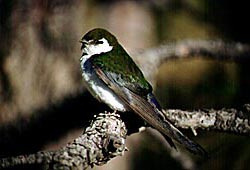
ContextKingdom: AnimaliaPhylum: Chordata Subphylum: Vertebrata Class: Aves Order: Passeriformes Family: Hirundinidae |
 |
Violet-green Swallow (Tachycineta thalassina). Photograph courtesy of Bryce Canyon National Park. |
Small swallow, about 4.75-5.25 inches (12-13 cm) long, with dark, metallic green upperparts and iridescent purple rump. Face, sides of rump, and underparts are white. Tail is slightly forked. Sexes are similar (Sibley, 2003).
Tachycineta thalassina inhabits coniferous and deciduous forests, preferring areas near lakes and streams. Also occurs around towns, in woodland clearings, and in canyons where snags are found (DeGraff and Rappole, 1995).
Breeds from Alaska east to South Dakota, south to southern California and Texas. It winters mostly south of the U.S. border into Mexico and Central America, but some winter in southern California (Waite, 2002-2005).
Diet mainly consists of flying insects. Forages over open areas, usually near water (Sibley, 2003).
The female will lay 4-5 white-colored eggs in each clutch. The incubation period ranges from 13-14 days and is carried out by the female (Ehrlick, et al., 1988). The nests are lined with grass and feathers and are made in abandoned woodpecker holes, natural tree cavities, crevices in rocky cliffs, niches of old buildings, and in old nests of Cliff Swallows where crevices are scarce (DeGraff and Rappole, 1995).
The Violet-green Swallow is very social and is often found in flocks of mixed swallow species and in single species flocks. They are extremely acrobatic and feed almost exclusively in flight (Seattle Audubon Society, 2005). Similar to Tree Swallow, but smaller with shorter tail and narrower wings. The call of this species is a high liquid chirping (Sibley, 2003).
DeGraff, R. M., and J. H. Rappole. 1995. Neotropical migratory birds: Natural history, distribution, and population change. Cornell University Press, Ithaca, 676 pp.
Ehrlich, P. D. Dobkin, and D. Wheye. 1988. The birders handbook: A field guide to the natural history of North American birds. Simon and Schuster, Inc., New York, 785 pp.
Seattle Audubon Society. 2005. Bird web. Violet-green Swallow. http://birdweb.org/birdweb/bird_details.aspx?id=323.
Sibley, D. A. 2003. The Sibley field guide to birds of western North America. Alfred A. Knopf, Inc, New York, 312 pp.
Waite, M. 2002-2005. What bird: The ultimate bird guide. http://whatbird.com/obj/195/_/Violet-green_Swallow.aspx.
Jacob Barton, March 2006.
